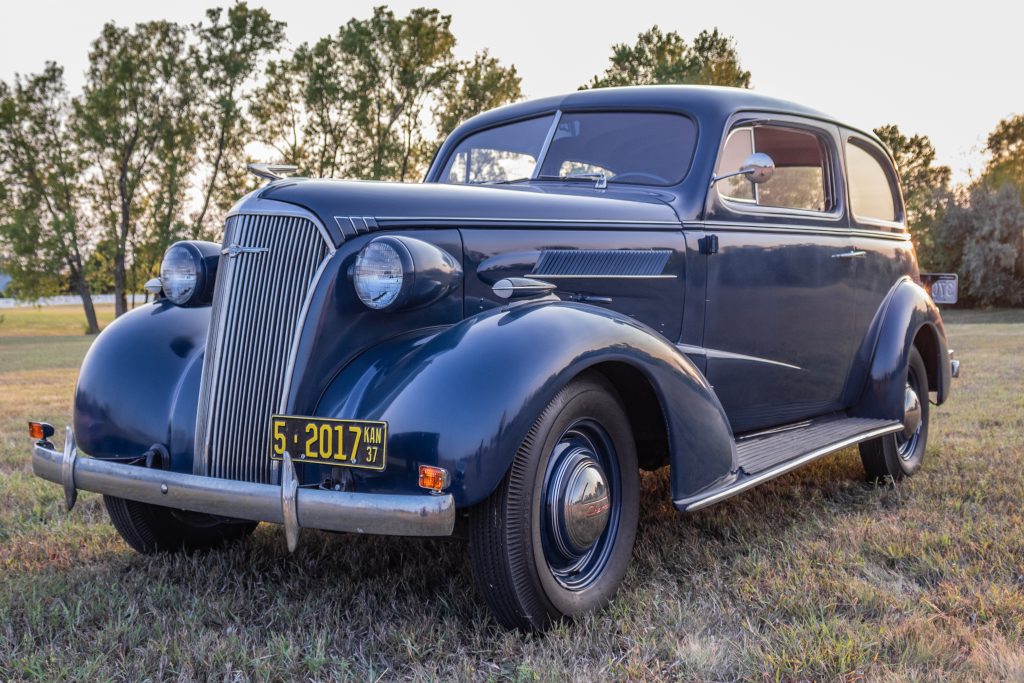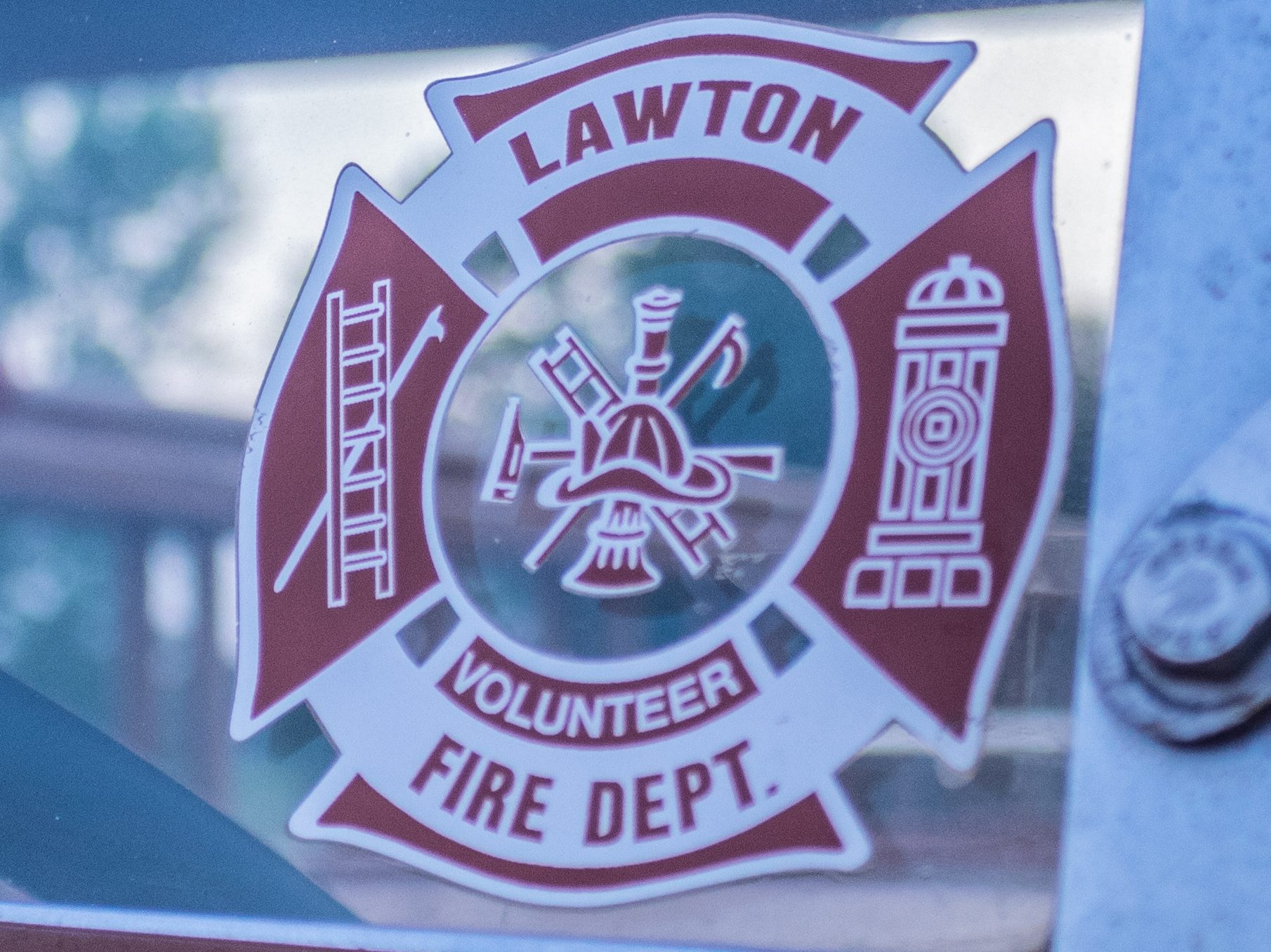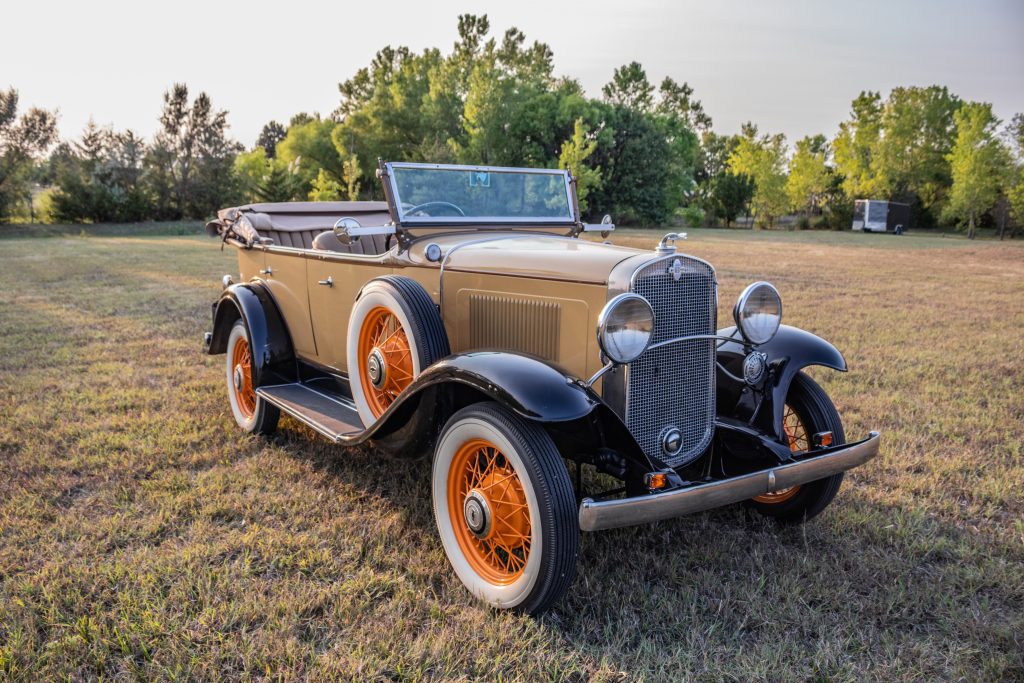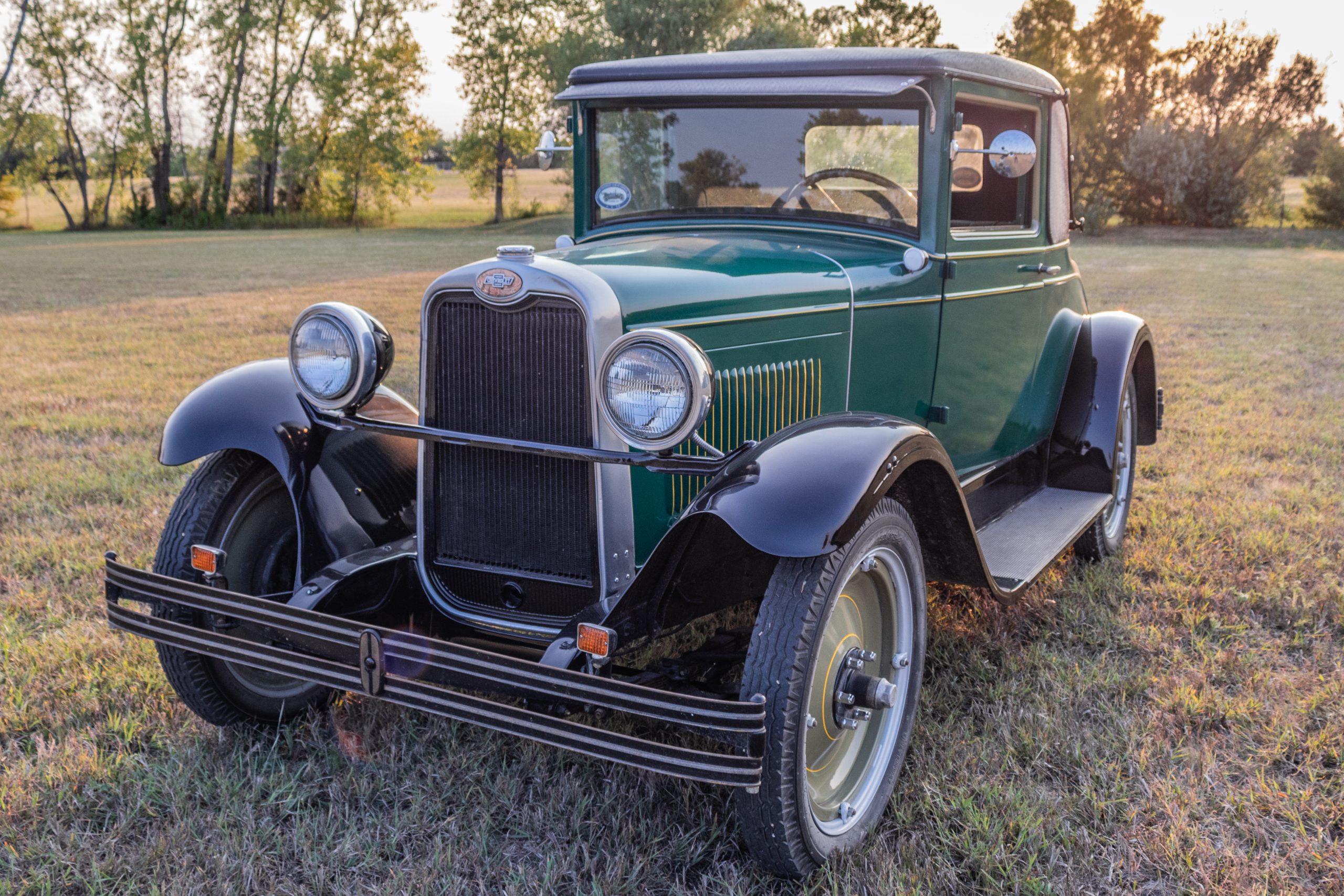
SPECIFICATIONS
ENGINE:
Cylinders: 6 Cylinders overhead valves
Bore/Stroke: 3 1/2” X 3 3/4”
Displacement: 216.5 Cubic Inches (3.4 Liter)
Compression Ratio: 6.25: 1
DRIVE LINE:
Transmission: 3 Speed Manual Floor Shift
Rear End Gear Ratio: 4.22: 1
Tire Size: 6.00 x 16
BRAKES:
4-wheel Huck Hydraulic
GASOLINE TANK CAPACITY:
14 Gallons
PURCHASE PRICE:
Cost in 1937 Dollars: $695
Cost in 2022 Dollars: $7,714
MILEAGE:
At Restoration in 1976: 0,000
September 2022: 8,215
Miles Driven: 8,215
COMMENTS
Calvin Eyres purchased the car in 1937 from Harner Chevrolet in LeMars, Iowa. In 1941 he purchased a new Buick and sold the 1937 Chevrolet to Janette Boehlke, a school teacher. Ms. Boehlke drove the car until 1955 when she purchased a new 1955 Chevrolet. By then the car had 82,000 miles (132,000 Kilometers) and was considered not worth anything on trade, so she parked it in a grove of trees behind her father’s home in Rural LeMars, Plymouth County, Iowa. There it sat until I purchased it in March of 1956.
The car is a Master two door sedan with bucket seats in the front and a bench seat in the rear. There is significant space between the rear and front seats. The Master Deluxe model had independent front suspension, with little clearance between the suspension and the front wheels which was not a desirable car for muddy Iowa farm roads. Persons like Calvin Eyres refused the Deluxe model and opted for the Master, which had an I-Beam front axle which was much more substantial and trouble free on muddy roads.
A FEW 1937 EVENTS
- Franklin Delano Roosevelt 32nd President, of the United States of America 1933 to 1945
- 1 January: Safety glass in vehicle windshield or windscreens becomes mandatory in the United Kingdom.
- 19 January: Howard Hughes sets a new air record by flying from Los Angeles, California to New York City in 7 hours, 28 minutes, 25 seconds.
- 5 February: President of the United States, President Franklin Delano Roosevelt proposes a plan to enlarge the Supreme Court of the United States.
- 3 May: Gone with the Wind’, a novel by Margaret Mitchell, wins the Pulitzer Prize for Fiction.
- 6 May: Hindenburg disaster: The Nazi Germany named German zeppelin ‘Hindenburg’ catches fire and is destroyed within a minute while attempting to dock at Lakehurst, New Jersey. Thirty-six people are killed.
- 12 May: The Duke and Duchess of York are crowned as George VI and Queen Elizabeth the Queen Mother of the United Kingdom of Great Britain and Northern Ireland in Westminster Abbey.
- 28 May: The Golden Gate Bridge in San Francisco, California, is officially opened by President Franklin D. Roosevelt in Washington, D.C., who pushes a button signaling the start of vehicle traffic over the span.
- 28 May: Volkswagen (VW), the Germany named German automobile manufacturer is founded
- 2 July: Amelia Earhart and navigator Fred Noonan are last heard from over the Pacific Ocean while attempting to make the first equatorial round-the-world flight.
- 5 July: Spam, the luncheon meat, is introduced into the market by the Hormel Foods Corporation.
- 28 August: Toyota Motors becomes an independent company
- 5 November: Adolf Hitler holds a secret meeting and states his plans for acquiring living space for the German people
- 29 December: The Irish Free State is replaced by a new state called Republic of Ireland known as Ireland with the adoption of a new Constitution of Ireland named constitution.
MY HISTORY WITH THE CAR
In January of 1956, my uncle, Calvin Eyres and his wife were involved in a severe car accident. He and his younger brother, Rodrick (Roddy) ran a dairy farm together and it required the combined work of both to manage the chores and work involved in caring for the cattle. As Calvin was spending considerable time with his own recuperation as well of his wife who was more seriously injured, Roddy was left alone. He asked if I would live with them for several weeks while Calvin was away and help with chores before and after school. They lived in the same school district as we did, so I was able to continue attending the same school.
Roddy paid me for the work, so by March when Calvin was able to return to the farm, I had accumulated enough money that I wanted to buy a car. I mentioned it to Calvin who said he knew of a car for sale, in fact he had purchased the car new. Upon arriving home, my father and I drove the three miles to Joe Boehlke’s farm to look at the car. It looked fairly good but the battery had run down, so it wouldn’t start but Joe assured me that it was running fine when he parked it, Jeanette simply wanted a new car so they parked it in the grove. We towed the car home and pushed it into the garage. I put a battery charger on the car and a few hours later hit the starter and was rewarded with the old engine coming to life and running fine. A short drive proved to be successful, so I paid Joe the $82.00 and took possession of my first car.
After driving it a few miles, Dad suggested I change the oil and check the transmission and differential to be sure they were properly filled. I drained and refilled the radiator with anti-freeze and began driving the car to school to avoid the ninety-minute school bus ride morning and evening when we lived only five miles from school.
At the time I bought the car, it had been painted black and even though the paint was in good condition, I really didn’t like the solid black color and decided to repaint the car to a more appealing color to me. A neighbor had a 1953 Chevrolet which was painted light green. After an accident, he had the top painted a light pink and I thought it made such a striking color combination I decided to paint my car the same color. Having no experience of any kind with painting a car, I went to a local body shop and by memory attempted to choose the colors Richard had on his ’53. Alas, I missed it by a huge margin and ended up with a dark metallic green and a very loud pink for the roof and hood above the belt line. While I was working for Roddy, I learned that he had a spray gun and compressor so asked if I could borrow it to paint my car.
I recruited a high school friend, Edward, to assist. We sanded the car using the sand paper the body shop recommended. We then masked the windows and chrome and made my first attempt at spray painting. Unfortunately, I had no idea how much to thin the paint and it came out in blobs. With no experience to guide us, and seeing the paint begin to dry, we grabbed a couple of paint brushes and began spreading the paint. From a distance, it looked fairly good, but as you got closer the brush strokes were visible. By then I had spent my savings on the car and paint, so hiring someone to do a proper job wasn’t possible. A week later, we painted the lower part of the body with the green paint with the same result. To say that everyone in the county knew Ron Eyres’ car was a gross understatement!
I drove the car from the time I purchased it in 1956 until I bought a 1954 Chevrolet Bel Air Hardtop in February of 1959. The dealer where I purchased the ’54 said he would give me $25 for the old Chevy, so I told him I would just keep it and let my younger brother have it as he now wanted a car of his own. Mike drove the car for some time, then like me decided he needed a nicer car so once again it was parked in a grove of trees.
The summer of 1960, I was back in Iowa working for an implement dealer doing service calls on New Holland farm equipment. Rather than use the ’54 Chevy to carry the tools and repair parts, I once again put the ’37 back in active duty and used it as my service vehicle, loaded with the appropriate tools. Due to the color, it was well known in the area. Customers commented that they always knew when help was on the way when they saw the pink top appear over the horizon. When I returned to college early in 1961, the car once again was parked in the grove.
A few years later, my youngest brother called me saying he and some friends were planning to visit our older brother in northern Kansas, would I like to have the old car back? I immediately agreed, so he drove it to Hiawatha, Kansas, probably during the summer of 1964. From there, my older brother then drove it to Wichita, however; on the way the engine began knocking loudly and he was afraid it may not make it all the way in. By driving slowly, it did survive the trip and once again it was back in my possession. There it sat in our back yard for a couple of years until we moved to a larger house. Although the house was larger, there was no room to move the old Chevy into the back yard, so I drove it to a friend’s farm near Rose Hill, Kansas, where it sat for several years. Unfortunately, water accumulated in the years of dirt resting in the bottom of the doors and quarter panels and it began rusting through.
In 1974, I saw an ad in the newspaper announcing the formation of a local chapter of the Vintage Chevrolet Club of America (VCCA). I attended the organizational meeting held at a restaurant in Wichita and became a charter member of the Air Capital Region of VCCA. That prompted me to begin the long-desired goal of restoring the 1937 Chevy to its original splendor. I dragged the old car home, and placed it in the corner of a friend’s construction business storage lot. There I began the disassembly of the car down to the bare frame. I took the engine home and tore it down, expecting to see a missing rod dipper causing the bearing to be burned up from lack of oil. Although I didn’t find a missing dipper, I did remove the crankshaft in two pieces! It had broken just in front of the second main bearing; thus, the very loud knocking was explained.
In the mean-time, I made a deal with another friend who owned a body shop. He wanted Central Heating and Air Conditioning installed in his home, so in trade for installing the equipment, he would do the body work on the ’37. I removed the body from the frame and took it to a company who had vats large enough to dip the entire body in a paint stripping solution, then in to a vat of Phosphoric Acid, which would remove all the rust. From there it went to the body shop. The owner of the body shop was so pleased with his air-conditioned house that he asked if I could install air conditioning in his shop. He offered to do the entire restoration of the body at no cost to me in trade for the work on his shop. Having no experience with body work, that was the solution to my greatest fear of body work and painting, for which I had no tools or knowledge.
While that was being accomplished, I rebuilt the engine, complete with a replacement crankshaft, rebored, new pistons and rods, along with a valve job. I got the engine back together and was able to run it on a test stand for an hour or so to be sure it was ready to return to service. My dad was visiting with his big Dodge Ram pickup, so we loaded the frame, front and rear axles, as well as most of the other heavy steel parts and took them to a sand blasting company. By then, I had acquired a small air compressor and a cup type spray gun. Utilizing some knowledge gained by watching the painter at the company where I worked, I attempted my first somewhat successful spray-painting job. I figured that the frame wouldn’t be seen after the car was restored so the main goal was protection from rust as well as learning how to regulate the spray gun and apply paint. As expected, there were a few runs, but by the time the frame was finished, I began to get the hang of it, so the front and rear axles, which would be visible, turned out much better.
The reassembly of the chassis began, and went pretty well. All the parts were there, so with a lot of cleaning, painting and careful attention to detail, I soon had the chassis rolling around. I installed the engine and connected the drive line, then hung the radiator by the hoses and some wire and was able to run the engine with the rear wheels off the ground and prove out the transmission and rear end. All went well, so I lowered it to the ground and drove it to the end of the block and back. That too went well, so with some additional assembly and adjustment of the brakes, determined it was ready for the body.
While I was doing all that work, the body shop completed the restoration and painting of the body, so I borrowed a trailer from a fellow club member and hauled the chassis to the body shop where for the first time in many years, the new looking body was married up to the chassis. Using the same trailer, I hauled the car back home and put it in the car port where the work continued. I had made a deal with a fellow church member to trade his upholstery work for a new furnace and central air conditioning in his home. A week later I completed my end of the bargain. Unfortunately, he failed to live up to his end of the bargain, so about nine months later I gave up on him and took it to an upholstery shop where they completed the job.
Back home once again, I went about doing the finishing touches. The running board metal had rusted completely through, but by using the VCCA club magazine and with the help of fellow club members, I was able to find other running boards. Unfortunately, they too were not usable, but by cutting and welding we were able to use the good parts of the two sets of running boards to come up with a usable pair. I then applied the new rubber covering and the job was finished, or at least as finished as my abilities allowed.
By now, it was 1977 and the Middle West Meeting of the VCCA was scheduled to be held in Wichita, Kansas, just a few miles from where we lived at the time. I entered the car in the judging and took third place in my class, which included cars in the same year time-frame. I was graded off for not having the correct wood-graining on the interior metal fittings of the car, and I had seal-beam head lights instead of the original bulb type lights. There were some issues with proper color of the under-hood components and the engine was not the proper gray color. Still, I was quite pleased with the third-place win in my first restoration attempt.
We drove the car around the local area and had it in a few shows, then moved to New Braunfels, Texas. From there, it went into storage in a museum until I was able to retrieve it in 2005 as noted elsewhere. I had taken steps in 1974 to prevent water from getting into the door panels, but alas, my attempts actually made matters worse instead of correcting the problem. I had used the urethane foam that Coleman used to make coolers and jugs, thinking that it would permanently seal the crevices and prevent moisture from attacking the metal, but instead of preventing the rust, it actually prevented the water from evaporating and made it worse. Thus, in about 2015 I began to see signs of rust emerging once again along the bottom of the doors and quarter panels.
In 2016, I once again began another restoration. By now I had quite a bit of experience with body work and painting, so I was able to remove the doors, cut out the rusted metal and install patches. After the appropriate body work, I painted the car using base-coat, clear-coat and ended up with a really nice paint job. I hired a man to do the proper wood graining on the interior parts, had the original windshield wiper motor repaired and installed, and once again the car looked almost like it did when it came from the factory. I haven’t entered it in any judging competitions, I just like having the car that I have owned for over 65 years running and dependable as it ever was!
TOURS AND SHOWS
After the first restoration in the mid 1970’s, I took the car to the MIDDLE WEST VCCA MEET held here in Wichita. I entered it in the judging and came out with a third-place win in the Junior category for my class. Following the judging, I led my very first VCCA tour from the hotel to the Coleman Factory in Wichita where we were given a tour of the new factory. Of special interest to me was that I had actually designed the first building in Coleman’s new manufacturing facility.
From then until we moved to Texas, we drove the car to church a few times and displayed it at various times when requested. One of my most memorable displays was at the Quality Chevrolet Dealership in the fall of 1976. The sales manager asked if I would bring the car to be put on display with the newly introduced 1977 Chevrolet cars. Thus, they would have a 1937 Chevrolet and a forty year later model, the 1977, on display in the same showroom. It was a real attention getter for the new car!
After moving to New Braunfels, Texas in 1979, we took the car with us and drove it in several parades held in the city. We also joined an antique car club and it was shown at various shows and displays. The longest display it was ever involved with was after we were transferred to Australia. I was looking for a place to store the car when our Rotary Club had Dick Burdick of Rosanke, Texas to speak about his antique cars, his involvement in the “Great American Antique Car Race,” and his museum. After showing him my car, he invited me to put it on display in his museum. Our agreement was that he wouldn’t charge me to store the car and I wouldn’t charge him to display the car! This was a classic “Win-Win Situation.” Although I had expected to be in Australia for only three years, that stretched to five years, then life was in such a turmoil that the car actually stayed in his museum from January of 1985 until March of 2005, or a total of twenty-five years! In that time, likely thousands of persons passed through the museum and had the opportunity to observe the 1937 Chevrolet.
After getting settled in our present location, I was able to retrieve the car in March, 2005 and within a week had it ready for our first VCCA SOUTHERN SPRING TOUR. The tour was held in Pittsburgh, Kansas from April 27 to 30. Since it was close and I didn’t yet own a trailer, we drove the car the one-hundred-sixty-miles to the tour hotel. We drove about 245 miles (395 Kilometers) on the tour and the car ran perfectly both to and from the tour as well as during the tour. In total this trip put 570 miles (915 kilometers) on the car. During the closing banquet, we were awarded a prize for having the car continuously owned 49 years of the cars driven to and from the tour.
The HCCA (Horseless Carriage Club of America) Spring Overnighter was held May 12 to 13, 2007. We drove from Wichita to Arkansas City, Kansas and toured around that general area driving about 250 miles (405 kilometers) visiting various museum, flea markets and the O’Henry Candy factory in Oxford, Kansas.
August 31 to September 2, 2007 saw the car in Emporia, Kansas for the 48th HCCA Air Capital tour. Again, since it was close, we drove the car to and from the tour hotel as well as on the tour. In total we drove the car 390 miles (630 kilometers) and again it ran perfectly with no problem.
September 20 and 21, 2008 saw us on and HCCA Fall Overnight tour. On this tour, we took Orpha’s brother and his wife along with us as we drove into southeast Kansas including Independence, Caney, Burden and Sedan, Kansas. We drove just over 220 miles (355 kilometers) with no problems until we were almost home. In the last twenty miles, I noticed the car beginning to heat up a bit and had to stop and add water to the radiator. I didn’t think too much about it as the car didn’t have a pressurized cooling system and it wasn’t uncommon for them to require coolant added from time to time.
With several other cars having been added to the stable, we didn’t drive the ’37 on another tour until September 15 to 18 in Pittsburg, Kansas. Again, we drove the ’37 to and from the tour and all together we drove 640 miles (1,032 kilometers), and as usual for the old car it ran perfectly with no hint of a problem. Since we were part of the organization committee, we were tour leaders one of the days.
2019 saw the car in Dubuque, Iowa for the VCCA SOUTHERN FALL TOUR. On the way to Dubuque with the ’37 on a trailer, we stopped by Pleasant Plain, Iowa and attended church where my ancestors had lived and attended in the mid 1800’s. Having the 1937 Chevrolet in the parking lot bought several favorable comments from the church goers! During the tour, we had major rain storms a couple of the days, but we were able to remain dry and comfortable having used the closed ’37 instead of one of the open cars.
Wichita, Kansas is the home of one of only two Boeing B-29 Bombers still flying. At a fund-raising event held at McConnell Air Force Base in Wichita, the organizers contacted the HCCA asking for 1930’s vintage cars to form a pathway from the parking lot into the warehouse where “DOC” was parked. Our 1937 Chevrolet was one of the cars utilized in this display.


